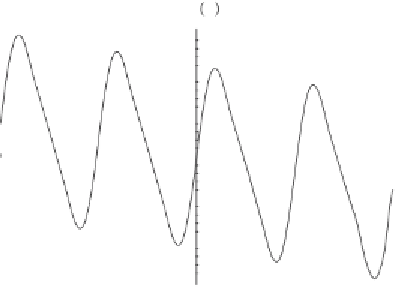Environmental Engineering Reference
In-Depth Information
V
eff
φ
1.5
1
0.5
φ
2
1
1
2
0.5
1
1.5
Figure 3.30. Tilting effect on the effective potential that is due to static force
F
(in
this example
F
=
0
.
2).
the distribution
p
(
tends to spread out similarly to the case of free diffusion
[see Fig.
3.29
(b)]. When the noise switches again to a low-intensity state, the shape
of the potential returns to play an important role. In particular, its asymmetry causes
an asymmetric redistribution of
p
(
φ
)of
φ
φ
) in the wells of
V
(
φ
) starting from the conditions
(i.e., the positions along the
axis) reached in the previous noise-dominated phase.
This redistribution gives rise to net transport. In the case of the example shown in
Fig.
3.29
, it is immediate to recognize a net transport in the positive (from left to right)
direction of the
φ
˙
0). However, with more complex combinations of
different noise modulations and shapes of the potential, it can be less difficult to
predict the direction of net transport (
Reimann
,
2002
).
A frequent and important variation of this simple scheme of Brownian motors is
obtained in the presence of an additive, homogeneous, deterministic force
F
,
φ
axis (i.e.,
φ
>
d
d
t
=−
d
V
d
d
V
eff
d
+
F
+
ξ
gn
(
t
)
=−
+
ξ
gn
(
t
)
,
(3.77)
φ
φ
where
V
eff
(
F
is the associated new potential. In this case it is easy
to recognize the effect of
F
on the drift. For example, Fig.
3.30
shows how the
presence of the additive deterministic component
F
tilts the potential
V
(
φ
)
=
V
(
φ
)
−
φ
), thereby
imposing a preferential direction to the random Brownian motion even when the
random component is time independent. Therefore, if
F
φ
=
0 there is a net transport
˙
(i.e.,
In this case the direction of the net transport
coincides with the sign of
F
. However, a less-obvious behavior emerges as an effect
of the time modulation in the noise term in dynamics (
3.77
). In fact, in this case
it is possible that noise-induced net transport prevails on the
F
-induced drift, thereby
allowing the dynamics of
φ
=
0) even when
T
(
t
)
=
const
.
to remount (on average) the “staircase” of the potential,
as shown in Fig.
3.31
. In this example positive values of
φ
˙
φ
exist in spite of the
negative sign of the force
F
.If
φ
is interpreted as the position of a particle subjected
















Search WWH ::

Custom Search